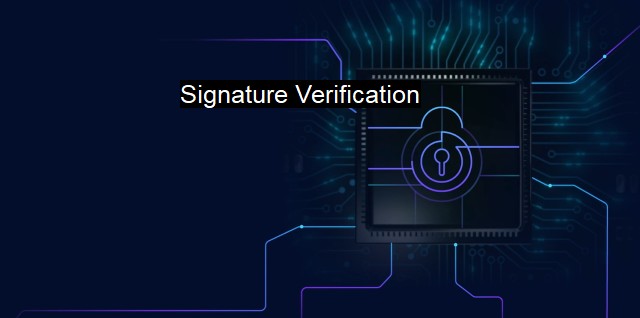What is Signature Verification?
Ensuring Secure Systems: The Importance of Signature Verification in Cybersecurity
Signature Verification is a vital element of cybersecurity, providing a critical layer of authentication to assure the identity and integrity of an entity, whether it's a user, software, or a device.The concept of signature verification is related to physical signatures. The handwritten identifier is unique to each individual; even an attempt to imitate the original can be distinguished with close examination. Cybersecurity provides the same scrutiny through its unique signature evaluation and guarantees the authenticity connected with that signature.
Signature verification is primarily about using cryptographic technologies to confirm a digital signature authentically represents the one it pertains to. These digital signatures secure and affirm the sanctity of the digital message, document, software, or a system they are linked with. Its roots embedded within the process of asymmetric encryption, which uses a set of public and private keys for encryption and decryption of data. Public keys are shared with everyone, while private keys are to be cloistered. Digital signatures are encrypted with private keys and can be decrypted by anyone with the corresponding public key, manifesting the level of security systems in transportation of data across insecure territories.
It is worth noting that signature verification is mostly used for validating the integrity of the message or the data and not necessarily impenetrable to prevent unauthorised access. when combined with other security layers, it amplifies the level of protection.
A substantial application of signature verification is found in antivirus software. Signature-based recognition is one of the three major methods of virus detection, along with heuristic and behavioural detection methods. Virus signature encompasses unique strings of code or even behaviours that characterise a known malware or virus. Antivirus vendors collate all the defined signatures into a malware dictionary, and these are incessantly updated as new threats emerge.
When new malware is identified by researchers, a signature describing that virus's specific characteristics, or "footprint," is established. Periodically the antivirus software checks the system and compares it with all the known threats encrypted by virus signatures. In doing so, it validates not only the existing data but also routinely screens every incoming file, ensuring protection in real-time.
Every piece of computer code has intrinsic characteristics that virus and malware detection software can locate and cross-reference against the malware dictionary to evaluate whether it's malign or benign. The choice to quarantine, delete, or warn the user rests on the outcome of this review.
Although exceedingly efficient against known threats, signature-based antivirus systems have their perimeters. As they rely on a database of known malicious code snippets or malware signatures, they can remain ignorant of an entirely new breed of malware. This 'zero-day threat,' as it's known, would remain undiscovered until antivirus companies can analyse, define a signature, and include it into the system's updated database.
Adding to the fact that malware constantly evolves, cybercriminals employ strategies like code obfuscation and polymorphism which allow the malware to change its code to evade detection. It requires algorithm-based heuristic detection and behavioural detection, which tries to identify malicious intent rather than known malicious code.
Regardless of these limitations, signature verification remains an indispensable line of defense in the realm of cybersecurity. In numerous real-world situations, this particular technique saves countless systems from being infected when new malware finds its way through security screening. The synthesis, sharing, and updating of new virus signatures play a massive role in limiting the spread of malicious software, making it a cornerstone in any cybersecurity arsenal.

Signature Verification FAQs
What is signature verification in cybersecurity?
Signature verification in cybersecurity is the process of verifying the authenticity of digital signatures attached to files, emails, or software. It is used as a security measure to ensure that the sender's identity is valid and that the content has not been tampered with during transmission.How does signature verification work in antivirus software?
In antivirus software, signature verification involves comparing the digital signature of a file with a database of known signatures of malware. If the signature matches, the file is identified as malware and blocked or removed. This process helps protect devices from various types of cyber threats, including viruses, worms, and trojans.Why is signature verification important in cybersecurity?
Signature verification is essential in cybersecurity as it helps prevent unauthorized access to sensitive data, protects against malware and cyber attacks, and ensures the integrity of software and other digital content. By verifying signatures, users can trust that the sender is authentic and that the file has not been tampered with during transmission. This is especially important for businesses and organizations that handle large amounts of confidential information.What are some challenges with signature verification in cybersecurity?
One of the challenges with signature verification is keeping the signature database up to date. As cyber threats evolve and new malware variants are developed, antivirus software must update its signatures to stay effective. Additionally, cybercriminals may use tactics to bypass signature verification or use polymorphic malware that changes its signature with each iteration, making it difficult to detect. Finally, signature verification alone may not be enough to protect against all cyber threats, and additional security measures may be necessary.| | A | | | B | | | C | | | D | | | E | | | F | | | G | | | H | | | I | | | J | | | K | | | L | | | M | |
| | N | | | O | | | P | | | Q | | | R | | | S | | | T | | | U | | | V | | | W | | | X | | | Y | | | Z | |
| | 1 | | | 2 | | | 3 | | | 4 | | | 7 | | | 8 | | |||||||